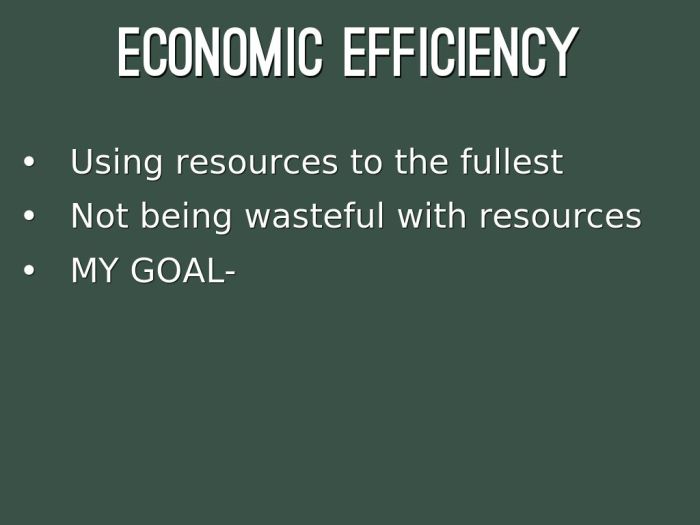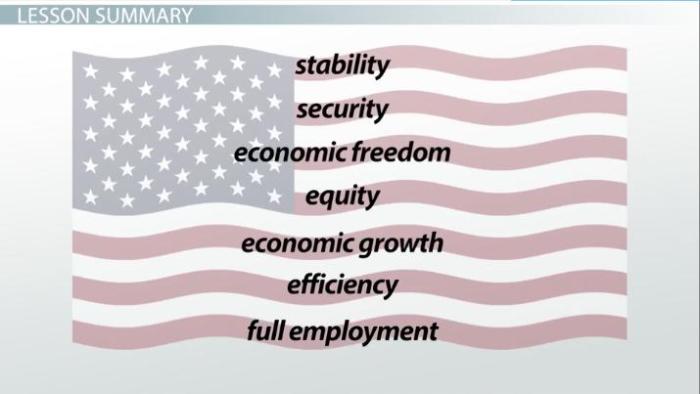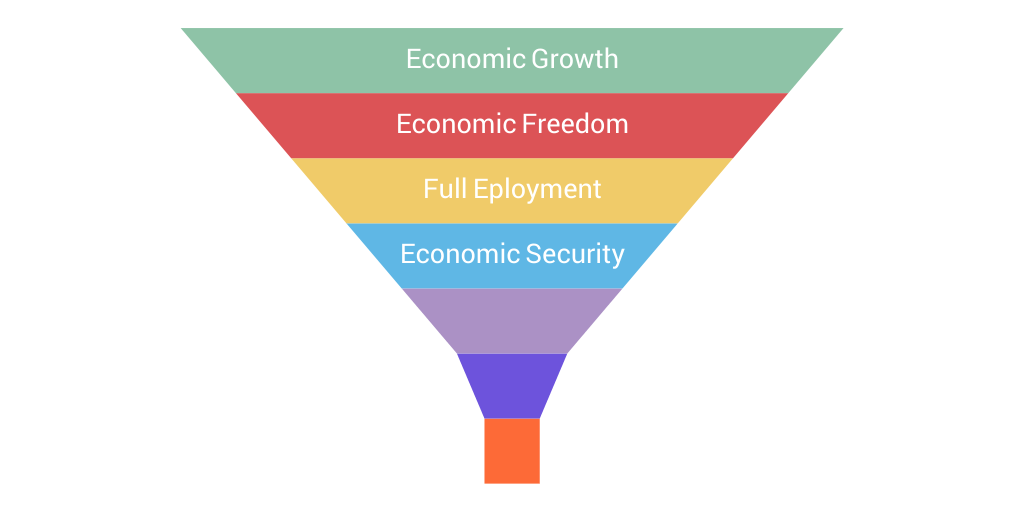What are the 6 economic goals? This question delves into the heart of economic policy, shaping nations’ aspirations for prosperity and well-being. From economic growth to equitable income distribution, these goals form the compass that guides governments in their quest to create thriving economies and just societies.
In this exploration, we’ll navigate the intricacies of each goal, examining their importance, challenges, and the strategies employed to achieve them. Join us on this journey to unravel the complexities of economic policy and its profound impact on our lives.
Economic Growth

Economic growth is a crucial indicator of a nation’s prosperity and well-being. It refers to the sustained increase in the value of goods and services produced within a country over time. Economic growth is essential for improving living standards, creating employment opportunities, and fostering overall economic development.
Numerous factors contribute to economic growth, including:
Technological Innovation
- Advancements in technology drive economic growth by increasing productivity, reducing costs, and creating new industries.
- Examples: The invention of the computer, the development of the internet, and the rise of artificial intelligence have all contributed to significant economic growth.
Capital Accumulation
- Capital accumulation refers to the investment in physical and human capital, such as machinery, infrastructure, and education.
- Increased capital stock enables businesses to produce more goods and services, leading to economic growth.
Labor Force Growth
- A growing labor force, with a skilled and educated workforce, contributes to economic growth by increasing the supply of labor.
- A larger and more productive labor force allows businesses to expand production and meet growing demand.
Economic growth has numerous benefits for citizens, including:
- Increased employment opportunities and higher wages.
- Improved living standards, with access to better healthcare, education, and housing.
- Reduced poverty and inequality, as economic growth creates wealth that can be distributed more equitably.
- Enhanced national competitiveness and global influence.
Price Stability

Price stability refers to a situation where the general price level of goods and services in an economy remains relatively stable over time, with low and stable inflation. It is a crucial economic goal as it ensures the stability of the economy and promotes economic growth.
Causes of Inflation and Deflation
Inflation occurs when the general price level rises over time, reducing the purchasing power of money. Deflation, on the other hand, occurs when the general price level falls over time, increasing the purchasing power of money.
Inflation can be caused by factors such as increased demand, rising production costs, or an increase in the money supply. Deflation can be caused by factors such as decreased demand, falling production costs, or a decrease in the money supply.
Impact of Inflation and Deflation
Inflation and deflation can have significant impacts on the economy.
- Inflation:High inflation can erode the value of savings, increase the cost of living, and make it difficult for businesses to plan and invest.
- Deflation:Deflation can discourage spending, lead to lower profits for businesses, and make it difficult for borrowers to repay their debts.
Tools for Maintaining Price Stability
Central banks use various tools to maintain price stability, including:
- Monetary policy:Central banks can influence the money supply through monetary policy tools such as open market operations, changes in reserve requirements, and changes in the discount rate.
- Fiscal policy:Governments can use fiscal policy tools such as taxation and spending to influence aggregate demand and help maintain price stability.
Full Employment

Full employment is a situation in which all those who are willing and able to work have a job. It is a desirable economic goal because it leads to a number of benefits for the economy.
One of the benefits of full employment is that it increases economic growth. When more people are working, they are producing more goods and services, which leads to higher levels of output. This can have a positive impact on the overall economy, as it can lead to higher levels of investment and consumption.
Another benefit of full employment is that it reduces poverty. When people have jobs, they are able to earn money and support themselves and their families. This can help to reduce the number of people living in poverty and improve the overall standard of living.
Causes of Unemployment
There are a number of factors that can lead to unemployment. One type of unemployment is structural unemployment, which occurs when there is a mismatch between the skills of the workforce and the jobs that are available. This can happen when new technologies are introduced or when industries decline.
Another type of unemployment is cyclical unemployment, which occurs during economic downturns. When the economy is slowing down, businesses often lay off workers in order to reduce costs. This can lead to a rise in unemployment.
Finally, there is frictional unemployment, which occurs when workers are temporarily unemployed while they are searching for a new job. This type of unemployment is usually short-term and does not have a significant impact on the overall economy.
Among the six economic goals, full employment and stable prices are crucial for economic prosperity. Just as a kappa sweetheart represents the epitome of loyalty and support within a fraternity, these economic goals symbolize the foundation of a thriving economy.
Policies to Promote Full Employment
There are a number of policies that governments can use to promote full employment. One important policy is to invest in education and training. This can help to ensure that the workforce has the skills that are needed by businesses.
Another important policy is to promote economic growth. This can be done by investing in infrastructure, providing tax incentives to businesses, and reducing trade barriers. When the economy is growing, businesses are more likely to hire new workers.
Finally, governments can use fiscal policy to promote full employment. Fiscal policy refers to the use of government spending and taxation to influence the economy. By increasing government spending or reducing taxes, governments can help to stimulate the economy and create jobs.
Balance of Payments Equilibrium

Balance of payments equilibrium refers to a state where the total value of a nation’s exports and capital inflows equals the total value of its imports and capital outflows. This equilibrium is crucial for a stable economy, as it ensures that a country can meet its international financial obligations without experiencing currency fluctuations or other economic disruptions.
Factors that affect a nation’s balance of payments include:
- Exports:Goods and services sold to other countries.
- Imports:Goods and services purchased from other countries.
- Foreign investment:Investments made by foreign entities in a country’s economy.
- Foreign aid:Financial assistance provided by other countries or international organizations.
Governments can implement various policies to achieve balance of payments equilibrium, such as:
- Fiscal policy:Adjusting government spending and taxation to influence economic activity.
- Monetary policy:Controlling the money supply and interest rates to affect inflation and economic growth.
- Exchange rate policy:Managing the value of a country’s currency relative to other currencies.
Stable Exchange Rates
Stable exchange rates refer to the situation where the value of a currency remains relatively constant against other currencies over a period of time. This stability is crucial for international trade, as it reduces the risks and uncertainties associated with currency fluctuations.
Factors that affect exchange rates include interest rates, inflation, and economic growth. Interest rate differentials between countries can influence the demand for a particular currency, as investors seek higher returns. Inflation rates can also impact exchange rates, as currencies of countries with higher inflation tend to depreciate against those with lower inflation.
Policies to Stabilize Exchange Rates
Governments can use various policies to stabilize exchange rates, such as:
- Intervention in the foreign exchange market:Central banks can buy or sell their own currency to influence its value.
- Interest rate adjustments:Changing interest rates can affect the demand for a currency and influence its exchange rate.
- Fiscal policy:Governments can implement fiscal policies, such as adjusting taxes or spending, to influence economic growth and inflation, which can indirectly impact exchange rates.
Equitable Distribution of Income: What Are The 6 Economic Goals

Equitable distribution of income refers to the fair and just distribution of income across a population. It ensures that the benefits of economic growth are shared by all members of society, reducing income inequality and promoting social stability.
Causes of Income Inequality
- Differences in education and skills: Individuals with higher levels of education and specialized skills command higher salaries.
- Variations in opportunities: Access to job markets, resources, and networks can significantly impact income levels.
- Discrimination: Prejudice and biases based on factors such as race, gender, or age can lead to unequal pay and career advancement opportunities.
Policies for Equitable Distribution of Income, What are the 6 economic goals
Governments can implement various policies to promote a more equitable distribution of income, including:
- Progressive taxation: Taxing higher income earners at a higher rate, providing additional revenue for public services and social programs.
- Minimum wage laws: Establishing a minimum level of pay to ensure a living wage for low-income workers.
- Education and training programs: Investing in education and skills development to increase opportunities for individuals to acquire higher-paying jobs.
- Social safety nets: Providing assistance to low-income individuals and families through programs such as unemployment insurance, food stamps, and housing assistance.
Top FAQs
What is economic growth?
Economic growth refers to the sustained increase in the value of goods and services produced within a country over time, leading to improvements in living standards and overall economic prosperity.
Why is price stability important?
Price stability maintains the purchasing power of a currency, preventing inflation (rapid price increases) and deflation (falling prices), which can disrupt economic activity and harm consumers.
How does full employment benefit the economy?
Full employment reduces unemployment, maximizes labor productivity, and boosts consumer spending, contributing to overall economic growth and stability.